Search the Special Collections and Archives Portal
Search Results
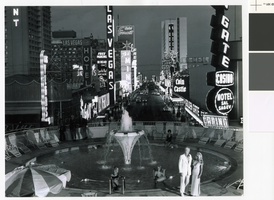
Photograph of Fremont Street from the Union Plaza (Las Vegas), circa 1970s
Date
1970 to 1979
Archival Collection
Description
Looking east down Fremont Street from the pool in front of the Union Plaza in the 1970s. Stamp on back of photo: "Las Vegas News Bureau, Convention Center, Las Vegas, Nevada, 25655, Don English, Jim Vorrup, Jerry Abbott, Joe Buck, Gary Angell, Tony King, Milt Palmer, Wolf Wergin, Lee McDonald, Herb Herpolsheimer."
Site Name: Union Plaza
Address: 1 South Main Street
Image

Photograph of Lone Wolf, Captain Joyce, and "Cunnell" Russell, Las Vegas (Nev.), 1932-1944
Date
1932 to 1944
Archival Collection
Description
Lone Wolf (a Blackfoot Indian from Browning, Montana and son of James Willard Schultz), Captain Joyce of Tucson, Arizona, and "Cunnell" Russell in the Cocktail Room of the Apache Hotel in Las Vegas, Nevada. The three men sit on the ground with a small boy in front of Joshua Trees and a painted desert scene. Lone Wolf is wearing traditional Native American clothing and the others are wearing Western cowboy style clothing. Site Name: Apache Casino (Las Vegas, Nev.)
Image
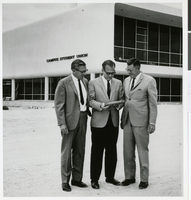
Photograph of Ed Von Tobel's sons receiving a plaque honoring their father, Las Vegas, May, 1968
Date
1968-05
Archival Collection
Description
Upon the death of Ed Von Tobel, Sr. on September 9, 1967, at the age of 94, his family learned he had made a bequest for a substantial sum to the University of Nevada, Las Vegas. A plague commemorating his generosity was presented by the University in May, 1968. At left is George Von Tobel and at right is Jake Von Tobel, sons of the company founder. In the center is Dr. Donald Moyer, former chancellor of UNLV. Physical object has an insert containing additional biographical information.
Image

Photograph of Indian leaders, Ruby Valley (Nev.), circa 1920
Date
1919 to 1921
Archival Collection
Description
Transcribed from the picture, "Shoshone - 4. Ruby Valley Indian leaders in a photo taken around 1920 at the cabin of Joe Temoke on the Overland Ranch in Ruby Valley. First row: John Carson, Joe Temoke, Lazy Jim, Billy Long, (standing) Andy, Frank Jim. Second row: Johnny Long, Joe Billy Smith, George Moore, John Nookie, Jack Temoke, Machach Temoke, Bert Moon. Third row: White Man, Friday Long, Seamond Temoke. Inter-Tribal Council of Nevada. Courtesy of Edna Patterson."
Image
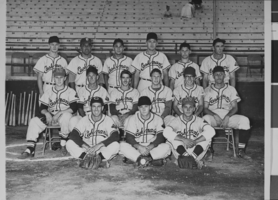
Photograph of the Cashman Cowboys at Helldorado, Las Vegas, circa 1954 - 1955
Date
1954 to 1955
Archival Collection
Description
A group photo of the "Cashman Cowboys" for the Helldorado event in Las Vegas, Nevada. The following men have been identified through UNLV's "Help Us Write History": (left to right) Front row: 1) Lou Pisani 2) (?) Reed 3) (?); Middle Row: 1) Johnny Oates 2) Joe Rowan 3) Hal Shoemaker 4) Chuck Hanley 5) Ken Olive 6) Jerry Goyneche; Backrow: 1) Dutch Rennert 2) John Tartan 3) Dean Hill 4) Marrin Einerwald 5) Fred Pinjuv 6) Forrest J. Woodward. Group Contributor credit goes to Recreation Department Photo.
Image
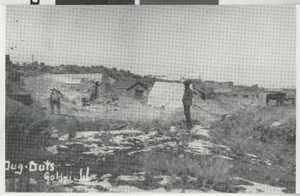
Postcard of dugout houses in Goldfield (Nev.), 1904
Date
1904
Archival Collection
Description
In most central Nevada mining camps, building materials were scarce during early development. Empty bottles, cans and stones were used to fabricate dwellings. In Goldfield, dugout homes were built into the walls of the two largest washes that crossed the townsite. The dugouts were cool in the summer and warm in the winter. The major disadvantage was size. Most were limited to one room. As building materials became available, conventional housing soon replaced the dugouts. The majority of Goldfield's dugouts were destroyed in the flood of 1923, although a few can still be found in the smaller washes on the west edge of town.
Image
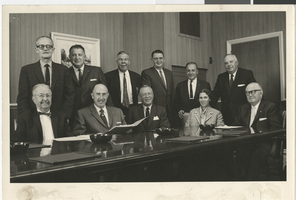
Photograph of Regents, Las Vegas, October 1961
Date
1961-10
Archival Collection
Description
A group photo of the Board of Regents at the University of Nevada, Las Vegas. The people who are standing are identified as, from left to right: 1) N. E. Broadbent; 2) Raymond Germain; 3) William Elwell; 4) Dr. Charles J. Armstrong (University President); 5) Chief Dep. Arry Gen. John Porter (Legal Advisor); and 6) Dr. Louis Lombardi (Vice Chairman). The people who are seated are identified as, from left to right: 1) Weld Arnold; 2) Dr. Fred Anderson; 3) Newton Crumley; 4) Mrs. Richard Magee (Molly Flag Knudtsen); and 5) A. C. Grant (Chairman).
Image
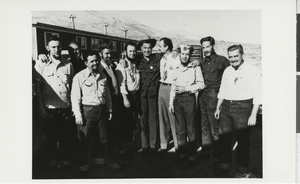
Photograph of men smiling in front of building, Tonopah (Nev.), 1930-1955
Date
1930 to 1955
Archival Collection
Description
Men stand in commrodery in front of a building, either belonging to the Lions Club or 20-30 Club in Tonopah, Nevada. Both were nonprofit organizations donating funds to locals in the Tonopah area. Transcription with photograph: "The Lions Club Building is in the background. The 20-30 Club became the Lions Club in the 1940's." Individuals identified from left to right: "1. Joe Friel 2. Roy Wolf 3. Charles Cavanaugh 4. Gerald Roberts 5. Fred Steen 6. Jack Depmsey 7. Unknown 8. Red Nelson 9. Allan Douglass 10. Red O'Leary."
Image
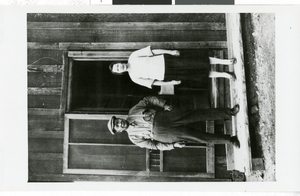
Photograph of Tom Wah and Gue Gim Wah, Pioche (Nev.), circa 1930
Date
1929 to 1931
Archival Collection
Description
Transcribed from behind the image,"'Tom Wah and Gue Gim Wah, his wife-when Tom's Chinese boarding house at the Prince Mine burned down, he moved into Prince one-room schoolhouse to serve meals (briefly one summer) later purchased the mine store from Hodges and Cook where a more adequate boarding house was again established- Tom died soon after. This photo taken in front of Prince schoolhouse, Pioche, Nevada.' Handwritten note by Elizabeth Gemmell Frizzell."
Image
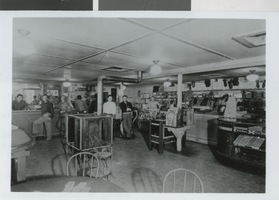
Photograph of the Black Mammoth Consolidated Mining Company's commissary, Mary Mine (Nev.), circa 1937
Date
1935 to 1937
Archival Collection
Description
There was an inscription on image. "#32. Black Mammoth Consolidated Mining Company commissary, Mary Mine, Nevada, ca. 1937. The Mary Mine is located five miles north of Silver Peak, Nev. and was developed by the Pittsburgh Silver Peak Gold Mining company between 1906 and 1916. The commissary was built in 1907. The mine was taken over by the Black Mammoth company in 1936 and operated until 1941. During this time the commissary, which housed a store, bar, entertainment center and boarding house, served over 150 men who worked at the mine. The Mary, a gold mine, produced over $7,800,000 between 1907 and 1941."
Image
Pagination
Refine my results
Content Type
Creator or Contributor
Subject
Archival Collection
Digital Project
Resource Type
Year
Material Type
Place
Language
